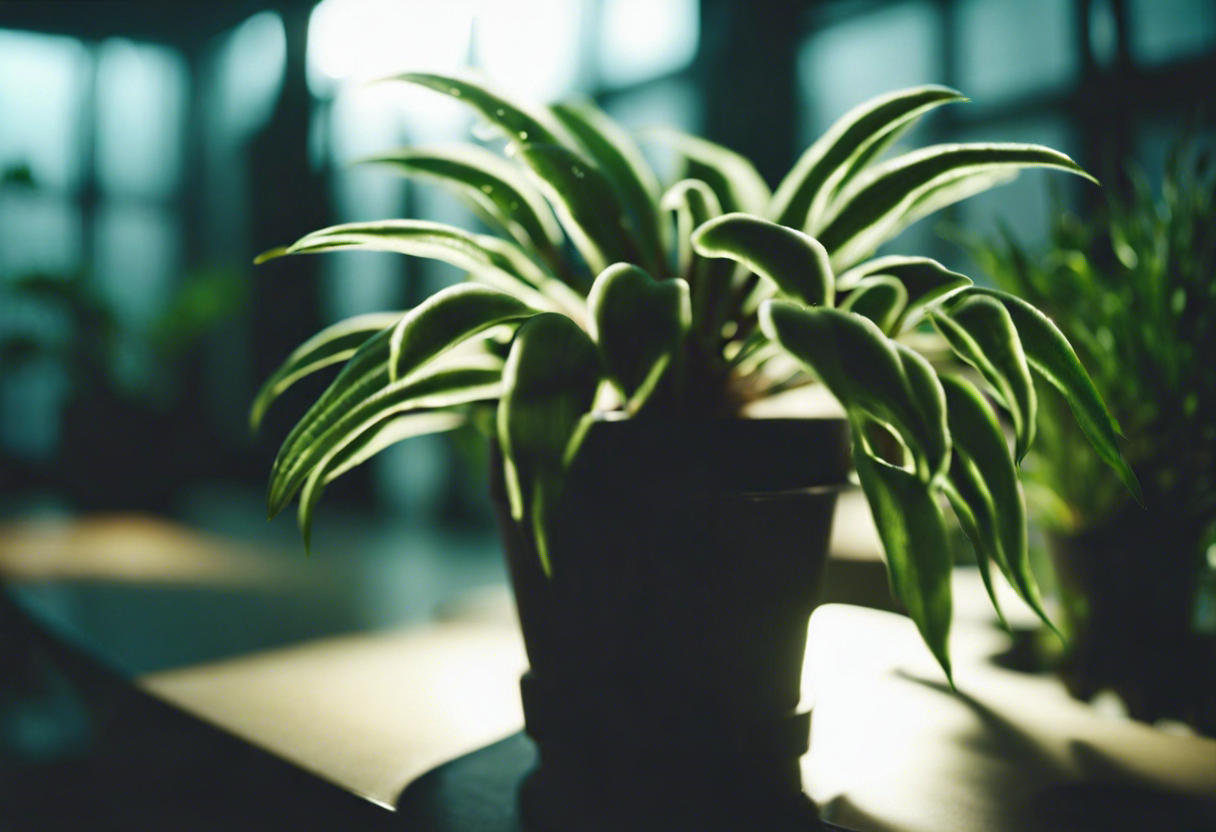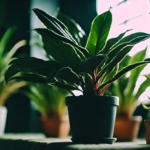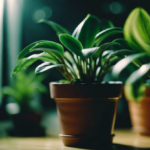Best Indoor Low Light Plants: Bring Life to Your Dim Space
When it comes to indoor plants, finding the perfect match for low light conditions can be a challenge. However, there are several varieties that thrive in dimly lit areas and can add a touch of greenery to your home or office. Whether you have a windowless room or just prefer a darker ambiance, here are some of the best indoor low light plants that are sure to flourish in even the darkest corners.
1. Snake Plant (Sansevieria Trifasciata)
The snake plant is a popular choice for low light environments because it can tolerate a wide range of conditions. Its long, sword-shaped leaves with vibrant green stripes add an elegant touch to any space. Not only does it require minimal care, but it also purifies the air by filtering out toxins, making it an excellent choice for improving indoor air quality.
2. ZZ Plant (Zamioculcas Zamiifolia)
The ZZ plant is a hardy indoor plant that thrives in low light conditions. Its glossy, dark green leaves retain moisture, making it perfect for those forgetful plant owners or frequent travelers. The ZZ plant is known for its air-purifying properties, effectively removing toxins like benzene and xylene from the air.
3. Pothos (Epipremnum Aureum)
Pothos, also known as Devil’s Ivy, is a versatile and easy-to-care-for plant. It can thrive in both low light and bright indirect light. Its heart-shaped leaves have variegated patterns, adding a touch of visual interest to any space. Pothos is known for its ability to purify the air by removing formaldehyde, a common indoor pollutant.
4. Dracaena (Dracaena Spp.)
Dracaena is a diverse genus of houseplants that can tolerate low light conditions. With its long, arching leaves and various leaf patterns, the dracaena adds a tropical vibe to any space. It is also known for its air-purifying abilities, effectively removing toxins like trichloroethylene and benzene from the air.
5. Cast Iron Plant (Aspidistra Elatior)
The cast iron plant is as tough as its name suggests and can thrive in almost any conditions, including low light areas. Its dark green, leathery leaves have a glossy finish, providing a unique and elegant look. Additionally, the cast iron plant is highly drought-tolerant, making it a perfect choice for those who tend to forget regular watering.
Indoor low light plants into your space not only brings a touch of nature indoors but also offers various benefits. These plants are not only aesthetically pleasing but also improve air quality by removing harmful toxins from the surroundings. So, why not brighten up your dim space with these resilient and beautiful low light plants?
Low Maintenance Indoor Plants for Low Light Conditions
When it comes to decorating our homes or offices, incorporating plants into the space can add a touch of nature and tranquility. However, not all spaces receive an abundance of natural light, which can make it challenging to find suitable plants that thrive in low-light conditions. Luckily, there are several low maintenance indoor plants that can thrive in such environments, bringing greenery and life to even the darkest corners. Here are a few options:
1. Snake Plant
The snake plant, also known as Sansevieria or mother-in-law’s tongue, is an ideal choice for low light environments. Its tall, upright leaves are known for their resilience and ability to adapt to a variety of light conditions. Snake plants are known to purify the air by removing toxins and produce oxygen even at night, making them perfect for bedrooms and offices.
2. ZZ Plant
The ZZ plant, scientifically known as Zamioculcas zamiifolia, is a popular choice for low light spaces due to its ability to thrive in almost any lighting condition. This plant has glossy, dark green leaves that add a touch of elegance to any setting. ZZ plants are known for their tolerance to low humidity and drought, making them extremely low maintenance and suitable for busy individuals.
3. Cast Iron Plant
The Cast Iron Plant, or Aspidistra elatior, is renowned for its ability to withstand neglect and thrive in low light conditions. Its dark green, glossy leaves can add a touch of elegance to any room, even without direct sunlight. Cast Iron Plants are known for their durability and resilience, making them an excellent option for offices and homes with minimal natural light.
4. Pothos
Pothos, also known as Devil’s Ivy, is a popular trailing plant that can adapt to a variety of light conditions. It has heart-shaped leaves that come in a range of colors, including variegated green and yellow. Pothos plants are not only beautiful but also excellent for purifying the air, making them an ideal choice for low light environments.
5. Dracaena
The Dracaena genus encompasses a variety of plants that are well-suited for low light conditions. With their striking foliage and air-purifying properties, Dracaena plants can bring life to any indoor space. They are available in different varieties, including the Dracaena marginata and Dracaena reflexa, both of which thrive in low light environments.
When caring for low light plants, it’s important to remember that while they require less light compared to other species, they still need some indirect light to thrive. It’s essential to place these plants near windows or well-lit areas of the room. Additionally, it’s crucial not to overwater them, as low-light environments may slow down their growth and reduce their water requirements.
By incorporating low maintenance indoor plants that thrive in low light conditions, you can transform dimly lit spaces into visually appealing areas filled with greenery and life. So, go ahead and bring a touch of nature to your home or office, even in the darkest corners.
Benefits of Indoor Low Light Plants for Home and Office Environments
Indoor low light plants are a perfect choice for those looking to bring nature indoors, especially in areas with limited natural sunlight. These plants are adaptable to the lower light conditions often found in homes and offices, making them an excellent addition to any interior space. The benefits of incorporating indoor low light plants into these environments are numerous and can greatly enhance the overall atmosphere and well-being of those who inhabit them.
One of the primary advantages of having indoor low light plants is their ability to improve air quality. These plants, such as the snake plant (Sansevieria), pothos (Epipremnum aureum), and ZZ plant (Zamioculcas zamiifolia), are known for their air-purifying properties. They can effectively remove pollutants and toxins from the air, helping to create a healthier and cleaner environment for everyone.
In addition to purifying the air, indoor low light plants also contribute to increased humidity in dry indoor spaces. Many homes and offices tend to have low humidity levels, which can lead to dry skin, respiratory problems, and even allergies. Plants release moisture through a process called transpiration, which helps to humidify the surrounding air. Having a few of these plants dotted around your space can help combat the dryness and create a more comfortable environment.
Moreover, the presence of indoor low light plants has been proven to boost mood and reduce stress levels. Studies have shown that being surrounded by greenery can have a calming effect on the mind and enhance overall well-being. These plants provide a connection to nature, which is often lacking in indoor environments. Their presence can create a sense of tranquility and relaxation, leading to increased productivity and improved mental health.
Another benefit of indoor low light plants is their ability to act as natural sound absorbers. In areas where there is a lot of ambient noise, such as open-plan offices or busy households, these plants can help to reduce echoing and dampen sound. Their foliage acts as a buffer, absorbing and diffusing the sound waves, creating a quieter and more peaceful atmosphere.
Indoor low light plants are relatively easy to care for, making them perfect for those who may not have a green thumb or much time to tend to plants. Most of these plants require minimal watering and can tolerate periods of neglect. They are hardy and resilient, meaning they can thrive in low light conditions without much fuss.
Incorporating indoor low light plants into home and office environments can bring a myriad of benefits, from improving air quality and increasing humidity to boosting mood and reducing stress. These plants not only enhance the aesthetics of indoor spaces but also contribute to a healthier and more inviting atmosphere. So, why not bring a touch of nature indoors and enjoy all the advantages these plants have to offer?
Popular Types of Indoor Low Light Plants and How to Care for Them
When it comes to choosing indoor plants for low light conditions, there are a variety of popular options available. These plants are not only perfect for bringing some greenery to areas with limited natural light, but they also require minimal care. Whether you are looking to add some life to your home or office, here are a few popular types of indoor low light plants and tips on how to care for them.
-
Snake Plant (Sansevieria): Known for its striking tall, pointed leaves, the snake plant is an excellent choice for low light environments. It is a hardy plant and can survive in various light conditions. Place it in a corner or a spot away from direct sunlight. The snake plant requires infrequent watering and can tolerate a wide range of temperatures.
-
Pothos (Epipremnum aureum): Pothos is one of the most popular indoor plants, thanks to its vibrant trailing vines. It does well in low light conditions and can tolerate a bit of neglect. Pothos prefers indirect light, so placing it near a north-facing window or in a room with filtered light is ideal. Let the soil dry out between waterings, and your pothos will thrive.
-
ZZ Plant (Zamioculcas zamiifolia): The ZZ plant is a perfect choice for those who tend to forget about watering their plants. It can survive in low light conditions and has impressive drought tolerance. Place it in a spot away from direct sunlight and water it only when the top inch of soil feels dry.
-
Peace Lily (Spathiphyllum sp.): The peace lily is prized for its beautiful white flowers and glossy green leaves. It can adapt well to low light environments, making it an ideal choice for offices or areas with limited natural light. Keep the soil slightly moist and avoid overwatering. The peace lily will also benefit from occasional misting to increase humidity.
-
Chinese Evergreen (Aglaonema sp.): With its attractive variegated leaves, the Chinese evergreen adds an elegant touch to any indoor space. It does well in low to medium light conditions and prefers to dry out slightly between waterings. Avoid placing it in direct sunlight, as it can scorch the leaves.
When caring for indoor low light plants, it’s essential to consider a few general tips. Firstly, make sure to choose pots with good drainage to prevent waterlogging. Secondly, avoid overwatering as it can lead to root rot. Instead, only water when the soil feels dry to the touch. periodic cleaning of leaves with a damp cloth will help remove dust and keep them healthy.
There are plenty of popular indoor low light plants that can thrive in areas with limited natural light. From the snake plant and pothos to the ZZ plant and peace lily, these plants can add beauty and greenery to your home or office. By following the care tips mentioned above, you can enjoy the benefits of these low light plants with minimal effort and have a vibrant indoor environment.
Arranging and Displaying Indoor Low Light Plants
When it comes to incorporating indoor low light plants, creativity knows no bounds. From small apartment spaces to large open office areas, there are countless ways to arrange and display these plants to enhance the aesthetics and ambience of any environment. Whether you’re a plant enthusiast or just starting your green journey, here are some creative ideas to inspire you:
1. Hanging Baskets and Macrame Planters
Add an element of charm to your space by suspending your low light plants in hanging baskets or macrame planters. These versatile options are not only great for small spaces but also create a visually stunning display. Be sure to choose plants that have trailing or cascading foliage for an eye-catching effect.
2. Ladder Shelves and Plant Stands
Ladder shelves and plant stands offer a practical and stylish way to showcase your indoor low light plants. These structures provide multiple levels of display, allowing you to create a visually interesting arrangement. Mix and match different plant heights, textures, and colors to create a cohesive and vibrant display.
3. Terrariums and Glass Containers
For a touch of whimsy and elegance, consider incorporating terrariums or glass containers into your indoor low light plant arrangements. These transparent vessels create a unique microenvironment for your plants and can be personalized with decorative elements such as pebbles, moss, or figurines. Choose plants that thrive in high humidity, such as ferns or mosses, for best results.
4. Vertical Gardens
If you’re looking to maximize your space and make a statement, vertical gardens are the way to go. These innovative displays allow you to transform bare walls into lush green havens. Use wall-mounted pots, shelves, or even repurposed materials like pallets to create your very own living wall. Opt for low light plants with compact growth habits, such as pothos or snake plants, for vertical gardening.
5. Unique Planters
Let your personal style shine through by choosing unique planters for your indoor low light plants. From vintage teacups to repurposed mason jars, the possibilities are endless. Decorative planters not only add a touch of personality but also make for great conversation starters. Keep in mind the specific needs of your plants and choose appropriate planter sizes and materials.
Remember, arranging and displaying indoor low light plants is a creative process, so don’t be afraid to experiment and find what works best for you. Consider factors such as lighting conditions, plant care requirements, and the overall aesthetic you wish to achieve. By incorporating these green companions into your space, you’ll not only boost its visual appeal but also create a calming and nurturing environment.
Conclusion
Indoor low light plants offer a variety of benefits for both home and office environments. These plants not only create a soothing and calming atmosphere, but they also purify the air, reduce stress, and improve overall well-being. With their resilience and ability to thrive in low light conditions, they are the perfect choice for those who want to bring a touch of nature indoors but have limited natural sunlight available.
When it comes to selecting the best indoor low light plants, there are several options to choose from. Snake plants, pothos, spider plants, and peace lilies are among the most popular choices. These plants require minimal maintenance and can survive in low light conditions, making them ideal for busy individuals or those without a green thumb.
Caring for indoor low light plants involves providing them with adequate water, avoiding overwatering, and occasionally dusting or wiping their leaves to keep them clean. It’s important to note that while these plants can survive in low light conditions, they still need some natural light to thrive. Placing them near a window or using artificial grow lights can help provide the necessary light for their growth.
One of the greatest advantages of indoor low light plants is their versatility in terms of arrangement and display. These plants can be placed in various creative ways to enhance the aesthetics of any space. They can be grouped together to create a charming indoor jungle, hung from the ceiling to add a sense of whimsy, or placed on shelves and tables to create a vibrant green display. The possibilities are endless, and it’s up to your imagination to create a unique and inviting indoor oasis.
Indoor low light plants are a fantastic addition to any home or office space. With their ability to thrive in low light conditions and their numerous benefits, these plants are a perfect choice for those who want to bring nature indoors. Whether you’re looking for low maintenance options or creative ways to arrange and display them, indoor low light plants offer plenty of options to suit your needs. So why not start incorporating these green beauties into your living or working environment and enjoy all the advantages they have to offer?


